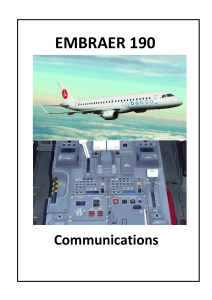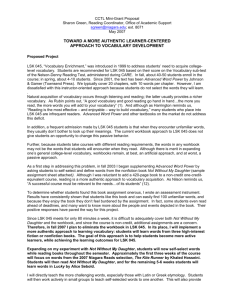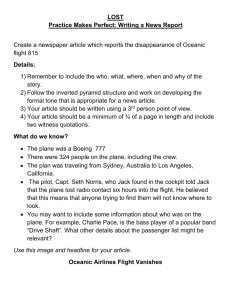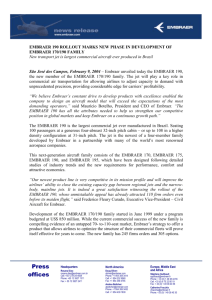Embraer 190 Communication Systems Summary
advertisement
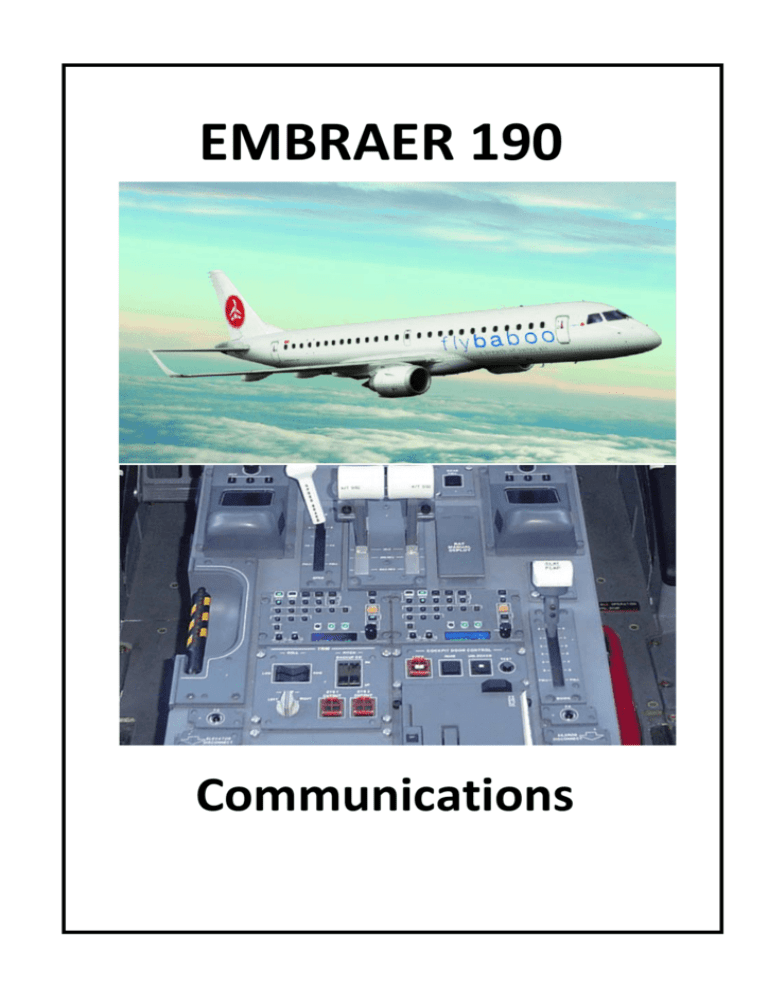
EMBRAER 190 Communications Embraer 190 - Systems Summary [Communications] The EMBRAER 190 provides a complete set of Communication functions. The main interface for the system is done through the Audio Control Panel (ACP). The audio system is controlled via three individual ACPs available to the captain, first officer and observer, and also provides interface with the Passenger Address (PA), Aural Warning, and Digital Voice and Data Recorder (DVDR) systems. Optional communications equipment includes a third VHF COM, HF and Selcal systems. CONTROLS AND INDICATIONS 1. CONTROL WHEEL - PTT (momentary) :allows VHF transmissions, as well as voice communications to passengers. - HOT : allows communication between crewmembers and ramp station. - OFF : allows only audio reception. crewmembers CONTROL WHEEL 1 MI P T T HR O SE T O F F OT E c DESCRIPTION CONTROL WHEEL COMMUNICATIONS SWITCH : C N° A TOP P S C AP S Page 1 −R and between Embraer 190 - Systems Summary [Communications] 2. GLARESHIELD COMMUNICATION N° c d DESCRIPTION GLARESHIELD PTT BUTTON : - Allows VHF transmissions and voice communications to passengers. PASSENGER ADDRESS PTT BUTTON : - Allows voice communications to passengers, regardless of any selection in the audio control panel. GLARESHIELD COMMUNICATION MAIN PANEL PTT CONTROL PEDESTAL 2 PA Page 2 Embraer 190 - Systems Summary [Communications] 3. HAND MICROPHONE CONTROLS N° c DESCRIPTION HAND MIC PTT BUTTON : - Allows transmission through the ACP, as well as communication to passengers. HAND MICROPHONE CONTROLS 1 1 Page 3 Embraer 190 - Systems Summary [Communications] 4. CAPTAIN AND FIRST OFFICER JACK PANELS N° c DESCRIPTION CAPTAIN AND FIRST OFFICER JACKS : - Allows plugging in headphone (PHONE), headset (ANR HDST), hand microphone (HAND MIC) and boom microphone (BOOM MIC). CAPTAIN AND FIRST OFFICER JACK PANELS 1 MIC PHONE BOOM MIC ANR HDST 1 Page 4 Embraer 190 - Systems Summary [Communications] 5. OBSERVER JACK PANEL N° c d DESCRIPTION OBSERVER JACKS : - Allows plugging in headphone (HDPH), headset (ANR HDST) and boom microphone (BOOM). OBSERVER COMMUNICATIONS SWITCH : - PTT (momentary) :allows VHF and voice communications with passengers. - HOT : allows communication between crewmembers and ramp station. - OFF : allows only audio reception. crewmembers and OBSERVER JACK PANEL OBSERVER STATION OBSERVER JACKS MICROPHONE BOOM HDPH ANR HOT OFF PTT HDST 2 1 Page 5 between Embraer 190 - Systems Summary [Communications] 6. RAMP STATION N° c d DESCRIPTION COCKPIT CALL BUTTON (momentary action) : - When pressed, generates a single HI/LO tone chime and the RAMP annunciator button flashes on the audio control panel. MICROPHONE/HEADPHONE JACK : - Allow ground personnel to plug in a headphone and a microphone equipped with a PTT Button. NOTE : Ground personnel panel is linked to the hot mic once the ramp button is selected. Page 6 Embraer 190 - Systems Summary [Communications] RAMP STATION 1 MAINTENANCE PANEL CKPT CALL LAN R A M P GCU / EPM MIC/PHONE I N P H 2 1 STEERING RAMP INPH 2 CKPT CALL AC GPU GROUND SERVICE SW LAN MIC/PHONE AVAIL IN USE 1 CKPT CALL R A M P G P U O/ V RLY MIC/PHONE I N P H 1 2 Page 7 EM170AOM140252.DGN PWR D C Embraer 190 - Systems Summary [Communications] 7. AUDIO CONTROL PANEL (ACP) N° c DESCRIPTION MICROPHONE SELECTOR BUTTONS : - Related communication channel is enabled for transmission and reception. - When selected, a green bar illuminates inside the button. AUDIO CONTROL BUTTONS : d - Related audio channel is enabled for reception. - Automatically activated when a transmission channel is selected. - More than one audio channel may be selected at the same time. - When selected, a green dot illuminates inside the button. e SATCOM CONTROL BUTTON (UNAVAILABLE) PASSENGER ADDRESS CONTROL BUTTON : f g h i j k - Enables PA announcements. - When selected, a green bar illuminates on the transmission button and a green dot illuminate on the reception button. SERVICES INTERPHONE CONTROL BUTTONS : - EMER : sounds a triple HI/LO tone chime through the PA system and illuminates a red light at ceiling of the flight attendant station. When selected, a green bar flashes on button until the flight attendant picks up the call. Once the flight attendant picks up the call the green bar flashes faster. Pressing the button again, the light becomes steady and the communication with the flight attendant is enabled. - RAMP : enables communication with the ground personnel. For an incoming call, the ramp annunciator flashes and remains steady on when active. A single HI/LO tone chimes. - CABIN : sounds a single HI/LO tone chime through the PA system and illuminates a green light at ceiling of the flight attendant station. When selected, a green bar flashes on button until the flight attendant picks up the call. Once the flight attendant picks up the call the green bar flashes faster. Pressing the button again, the light becomes steady and the communication with the flight attendant is enabled. MASTER VOLUME CONTROL KNOB : - Allows adjustment of the most recently selected audio. ID FILTER BUTTON : - Activates a filter that eliminates voice on VOR and ADF audio so the identification can be heard. AUDIO SELECTION BUTTONS : - Enables the respective audio to be summed into the output on the headphone (HDPH), interphone (INPH) or cockpit speaker (SPKR). - When selected, a green dot illuminates inside the button. ACP DISPLAY : - Displays the selected transmission channel and digital volume information. Page 8 Embraer 190 - Systems Summary [Communications] N° l DESCRIPTION AUTO/MASK MICROPHONE SWITCH : - AUTO (PUSH IN) : allows audio communication via oxygen masks. - MASK (PUSH OUT) :activates oxygen masks microphone when auto mode fails. - Oxygen mask stowage box doors must be closed and reset in order to enable hand or headset microphone booms after using the oxygen mask microphone. BACKUP VOLUME CONTROL BUTTON/KNOB : - NORM (PUSH IN) : 11 normal operation mode. - BKUP (PUSH OUT) : activates backup operation when audio panel power fails or both digital audio buses fail. - Minimum volume is at the extreme counterclockwise position and the maximum volume is at the extreme clockwise position. - The VHF 1 is the radio available for Captain ACP and VHF 2 is the radio available for the First Officer ACP. SELCAL ANNUNCIATOR BUTTON : 12 - Flashes when an incoming call is displayed. - Pressing shows the code on the ACP display. - Remains steady when active for transmission. Page 9 Embraer 190 - Systems Summary [Communications] AUDIO CONTROL PANEL (ACP) CONTROL PEDESTAL OBSERVER STATION 1 3 2 4 MIC VHF1 VHF2 VHF3 HF SAT NAV1 NAV2 NAV3 ADF1 ADF2 DME1 DME2 MKR PA AUD EMER BKUP RAMP SPKR INPH CAB HDPH VOL MIC VHF1: 47 NORM BKUP 12 11 AUTO MASK 9 10 Page 10 8 7 6 5 EM170AOM140151A.DGN SELCAL ID Embraer 190 - Systems Summary [Communications] 8. DIGITAL VOICE-DATA RECORDER N° c d e DESCRIPTION SELECTOR SWITCH : - FWD : enables test functions of DVDR 1, which is located in the forward electronic bay. - AFT : enables test functions of DVDR 2, which is located in the aft electronic bay. HEADPHONE JACK : - Monitors tone transmission during test or to monitor playback of voice audio. TEST BUTTON : - Simultaneously tests all CVR and FDR functions on each DVDR. The DVDR on which the test will be performed is selected on the Selector Switch. - An aural tone is heard through the headset if the unit passes the test. NOTE : - Erases the recorded audio information, provided that the airplane is on the ground and parking brake is set. DIDITAL VOICE-DATA RECORDER OVERHEAD PANEL DVDR CONTROL PANEL AFT FWD CVR DVDR ERASE TEST 4 Page 11 3 HEADPHONE 2 1 EM170AOM140125.DGN f An aural tone is heard only for airplanes equipped with Honeywell DVDR. For airplanes equipped with L3 DVDR, observe that there are no FAIL messages on EICAS. CVR ERASE BUTTON : Embraer 190 - Systems Summary [Communications] 9. PRINTER N° c d e f g h DESCRIPTION PPR ADV : - Continuously advances paper while pushbutton is depressed. LOW PPR : - Illuminates when the printer senses the last remaining 10 feet of paper on the paper supply roll. TEST BUTTON : - Illuminates all indicators followed by a printout of test results and a test pattern. - "TEST" button indicator bar will remain lit in conjunction with the "FAULT" indicator to report a self test failure. ALRT RST BUTTON : - Not functional. FAULT BUTTON : - Illuminates when senses no paper or printer door open. - Illuminates in conjunction with test button in case of self-test failure. OFF BUTTON : - Alternatively turns the printer off and on. When power is applied to the printer, it automatically is in the on state. PRINTER OPEN PUSH CONTROL PEDESTAL 6 OFF 5 FAULT ALRT RST 3 TEST 2 PUSH TO CLOSE 4 LOW PPR OPEN PUSH PPR ADV Page 12 EM170AOM140478A.DGN 1 Embraer 190 - Systems Summary [Communications] COMMUNICATION SYSTEM The communication system comprises the radio communication (VHF), interphone, audio control panels and digital data voice recorder. 1. RADIO COMMUNICATION SYSTEM 1.1. VERY HIGH FREQUENCY The VHF digital radios (VDR) 1 and 2 are located in the Modular Radio Cabinets (MRC). VDR 1 and 2 interfaces with the audio system through the audio/microphone busses, and with the MCDU/PFD through the ASCB. VDR channels 1 and 2 are for voice communication only. VDR 3 interfaces with audio system and MCDU/PFD indirectly via MRC 2 and directly to MAU 1 to data transmission. The VHF radio 3 is located on a separated radio Mini Cabinet. VDR 3 provides voice communication as well as data communications through ACARS (Aircraft Communication Addressing and Reporting System) applications. The VHF frequency is tuned/activated through the MCDU (primary mean) or CCD (PFD). A tuning backup is available in MCDU 2 in case of loss of both MAUs. In the same way, if the audio bus is lost there are audio backups. The flight crew may tune the VHF frequency on the MCDU as follows : • Press RADIO button on the MCDU to go to RADIO page 1/2. RADIO PAGE 1/2 : • On RADIO page 1/2 is possible to tune and activate the VHF 1 and 2 frequencies. The tuning can be accomplished using the tuning knob or the numeric buttons. If the tuning knob is used the standby frequency must prior be boxed pressing its respective line select key. In case of the numeric keys, enter the standby frequency and press the respective line select key. To activate the standby frequency press the respective active frequency, • Press the respective standby frequency twice if not boxed, otherwise press once, to go to COM page 1/1. COM 1 (2) PAGE 1/1 : • On the COM page is possible to capture a frequency tuned in memory. Press 3L to box the memory tune and use the tuning knob to cycle the stored frequencies. Press the active frequency to capture the selected memory tune, • Press line select key 1R to cycle to the squelch on or off, • Press line select key 3R to cycle to the frequency spacing : - 8.33: frequency has three decimal places, - 25: frequency has two decimal places. • Press line select key 6L to go to COM MEMORY page 1/2. Page 13 Embraer 190 - Systems Summary [Communications] COM MEMORY PAGE 1/2 : • On the COM MEMORY page is possible to capture a frequency tuned in memory or store a frequency/identification. To capture a frequency press the respective memory frequency to box it and press 1L to activate the frequency. To store a frequency or its identification use the alphanumeric keys and press the respective memory line select key. Additionally the frequency can also be stored pressing the receptive memory line select key and rotating the tuning knob. RADIO PAGE 1/2 RADI O COM1 1 / SQ COM2 12 3 . 2 0 0 12 3 . 2 0 0 118 . 6 0 0 118 . 6 0 0 NAV1 114 . 8 DME H PXR 115 . 6 2 F MS AUT O NAV2 117 . 4 116 . 8 N 12 3 XPDR 14 7 1 T CAS/ XPDR ST BY T A/ RA I DENT The VHF frequency selection through the CCD is as follows : • Select the PFD through the CCD. The left and right format location buttons select respectively pilot's and copilot's PFDs, • Tune the standby frequency through the tuning knob. Activate the standby frequency by pressing the enter key. Page 14 Embraer 190 - Systems Summary [Communications] RADIO PAGE 2/2 : • To bring up the RADIO PAGE 2/2, with the radio PAGE 1/2 displayed, press NEXT button, • On RADIO page 2/2 is possible to tune and activate the VHF 3 frequencies for voice mode. Press line select key 6L twice to go to COM 3 page 1/1, and then press line select key 2R to cycle the operational mode (data or voice). It is possible to tune a radio frequency in the same manner as VHF 1 and 2, • The frequencies to data transmission are selected in a specific ACARS page. With data mode selected, the indication 'DATA' displays, otherwise VHF 3 active and stand by frequencies display. RADIO PAGE 2/2 (DATA MODE) RADI O 2 / 2 1L ADF 1 230 . 0 1R 2L 365 . 0 2R 3L 3R 4L 5R 6L 6R RADIO PAGE 2/2 (VOICE MODE) RADI O SQ ADF 1 2 / ADF 2 230 . 0 235 . 5 365 . 0 360 . 0 HF 1 8 . 8550 UV 10 . 0 9 6 0 COM3 12 1 . 7 118 . 5 P Page 15 2 EM170AOM140490A.DGN 5L 4R COM3 DAT A Embraer 190 - Systems Summary [Communications] COM 3 PAGE 1/1 : • The COM 3 page provides the same options as COM 1 (2) pages, except that is possible to select the transmission mode for VHF 3. The transmission mode is selected pressing line select key 2R to cycle the operational mode (data or voice). COM PAGE 1/1 COM 3 2L ACT I VE SQUEL CH 12 3 . 2 0 0 ON 118 . 0 0 0 1 - KDVT 118 . 4 0 0 1R MODE PRESET DAT A VOI CE MEM T UNE 3L OF F 2R F REQ 8 .3 3 T WR 25 3R 4L 4R 5L 5R 6L MEMORY RADI O 2 / 2 Page 16 6R EM170AOM140491A.DGN 1L 1/ 1 Embraer 190 - Systems Summary [Communications] BACKUP RADIO PAGE : • The BACKUP RADIO page provides means for tunning COM 1, VHF NAV 1 and XPDR 1 (ALT OFF mode) in case of loss of primary and secondary tuning means (tuning using MCDU and CCD). In such cases, radio access is done via backup connection available on MCDU 2, • The BACKUP RADIO page is available pressing MENU function button on the MCDU and then line select key 4L on Menu page. The BACKUP RADIO page displays automatically on MCDU 2 for some failure conditions. MENU PAGE 1/1 BACKUP RADIO PAGE 1/1 BACKUP RADI O 1L COM1 12 3 . 2 OO 1R 2L 365 . 0 2R 3L NAV1 114 . 8 O 3R 4L 11O . 6 O 4R XPDR 14 7 1 5L 6L ST BY AL T - OF F Page 17 I DENT 5R 6R Embraer 190 - Systems Summary [Communications] NAVIGATION AND COMMUNICATION SCHEMATIC LAN TUNNING BACKUP MCDU 1 MAU 1 CMF 2 CMC CCD 1 CCD 2 MCDU 2 MAU 3 MFD 1 PFD 1 MFD 2 PFD 2 MAU 2 CMF 1 ASCB ANTENNA HF AUDIO BACKUP ANTENNAS MRC 2 MRC 1 VHF 2 XPDR 2 ADF 2 VHF 1 XPDR 1 ADF 1 ANTENNAS AUDIO / MICROPHONE BUS AUDIO PANEL 2 AUDIO PANEL 3 AUDIO PANEL 1 EM170AOM140600B.DGN VHF 3 AUDIO BACKUP ANTENNA 2. SELECTIVE CALLING Selective Calling (SELCAL) monitors selected frequencies on the VHF and HF radios in case of the ground station is desiring to communicate with the flight crew. Each airplane is assigned of a unique four-letter SELCAL code. Page 18 Embraer 190 - Systems Summary [Communications] 3. INTERPHONE SYSTEM The interphone system provides intercommunication between the flight crew, flight attendants and ramp personnel. The flight attendants communicate between flight attendant stations or with the flight crew using any of the attendant handsets. Communication between flight crew and flight attendants may be done through the ACP. Call chimes are annunciated at the beginning of the call from the cockpit to the flight attendants and vice-versa. 3.1. PASSENGER ADDRESS (PA) The PA system allows flight crew in the cockpit and flight attendants to make announcements to the passengers. Announcements are heard through speakers located in the cabin and in the lavatories. The pilots can make announcements using hand, headset boom or oxygen mask microphones. The flight attendants can make use of PA handset located at their stations. Pre-recorded announcements may be provided as well as recorded music for passenger entertainment. PA system use is prioritized. Cockpit announcements have first priority and override all others. Flight attendant announcements override the pre-recorded announcements and this one overrides the music system. 3.2. ATTENDANT CALL The call system is used as a mean for crewmembers to gain the attention of other crewmembers and to indicate that interphone communication is desired. Attention is gained through the use of lights and aural signals (chimes or horn). The cockpit may be called from either flight attendant station or by the ground personnel. The ground personnel may only be called from the cockpit. Flight attendants may be called from the cockpit through interphone buttons on the ACPs or flight attendant call button on the overhead panel, the other attendant station, or from any passenger seat (PSU) or lavatory. Call lights in the passenger cabin identify, the source of incoming calls to the attendants. Call system chime signals low, high or high/low tones are audible in the passenger cabin through the PA system speakers. The PA speakers also provide an alerting chime signal whenever the NO SMOKING, FASTEN SEAT BELT or RETURN TO SEAT (in the lavatory) signs and STERILE COCKPIT light illuminate or extinguish. The attendant call lights located on the forward and aft main ceiling panel areas provide a visual indication to attendant when there is a call from the flight crew or passengers. Page 19 Embraer 190 - Systems Summary [Communications] 3.3. ATTENDENT CALL TABLE VISUAL SIGNAL AT CALLED POSITION AURAL SIGNAL AT CALLED POSITION Green light Single high/low tone chime Red light Triple high/low tone chime Amber sterile cockpit light Single high tone chime Passenger cabin, lavatories and galleys No smoking or fasten belt signs illuminate/ extinguish Single low tone chime Cockpit (lateral console) Ramp station - Horn in the nose wheel well Cockpit (Overhead Panel) Attendant station - Single high/low tone chime Cockpit CAB or EMER annunciator button flashes on the ACP Single or triple high/low tone chime for CAB or EMER, respectively Attendant station - Single high/low tone chime Ramp station Cockpit RAMP annunciator button flashes on the ACP Single high/low tone chime Lavatory Attendant station Orange light Single high tone chime Passenger PSU Attendant station Blue Single high tone chime CALLING ORIGINATOR CALLED POSITION Attendant Station Cockpit Attendant station 4. AUDIO CONTROL PANEL There are three Audio Control Panels (ACP), located at the control pedestal and observer station. Each panel controls an independent crew station audio system and allows the flight crew to select the desired radios, navigation aids, interphones and PA systems for monitoring and transmission. The audio panel receives inputs from all audio communication channels and aural warnings. Audio warning for altitude alert, ground proximity warning system (GPWS), traffic collision avoidance system (TCAS), and windshear among others, are also heard through the speakers and headsets. These warnings cannot be controlled or turned off by the flight crew. Audio from each ACP is monitored using a headset, headphone or the related speaker, except for the observer speaker. Page 20 Embraer 190 - Systems Summary [Communications] 5. DIGITAL VOICE DATA RECORDER SYSTEM (DVDR) The digital voice data recorder system (DVDR) combines a flight data recorder (FDR) and a cockpit voice recorder (CVR) in a single unit. Two DVDR units are installed. DVDR 1 is installed in the forward electronic bay, and the DVDR 2 in the aft electronic bay. Each unit is capable of receiving, recording and preserving all required data parameters and voice recording from the cockpit crew and area microphones. The DVDR unit is capable of recording the last 120 minutes of audio information from cockpit area microphone and primary crew microphones, 25 hours of flight data, 120 minutes of digital communication messages and GMT as well. There is DVDR's FDR data available for maintenance purposes only through the MCDU. 6. COMMUNICATION MANAGEMENT FUNCTION The Communication Management Function (CMF) provides the following functionalities : • Character-oriented communication through ACARS network, • Communication between different airplane devices. CMF is a dual mode active/stand by system. CMF 1 resides in MAU 3 and is powered by DC bus 2. CMF 2 resides in MAU 1 and is powered by DC bus 1. CMF has the following interfaces : • ACARS network, • MCDUs are the primary flight crew interface with CMF providing display and control for the CMF. CMF becomes available pressing MCDU DLK button, • Printer receives ACARS exchanged messages via CMF, • CMC receives fault/events reports from the CMF. CMC also provides communication between the CMF and Printer device, • PFD displays a "MSG" flag when uplink messages are received from ground, • EICAS alerts crew members of CMF faults, • AWS alerts crewmembers of new ATS (Air Traffic Services) uplink messages. 6.1. ACARS ACARS is a data link system that allows character-oriented messages to be exchanged between ground stations and the airplane. Messages divide in two groups : • Addressed to or by crewmembers: data link requests or free text reports ; • Automatically sent: reports of flight data, performance data and routine events. Communication to ground stations are made through VDR 3 channel. MCDU provides interface with ACARS applications to crewmembers. Page 21 Embraer 190 - Systems Summary [Communications] ACARS applications are : AIR TRAFFIC SERVICE APPLICATIONS • ATIS (Air Traffic Information Service) Reports application enables the flight crew to send a downlink message requesting an uplink report that may be a specific airport information or an en route information, • Departure Clearance Application is used to request a departure clearance through characteroriented messages instead of voice communication, • Expected Taxi Clearance is used to request a taxi clearance through character-oriented messages instead of voice communication, • Flight System Message Application is used to display unsolicited uplink messages that provide additional information then that provide in an Oceanic or Departure Clearance, • Oceanic Clearance Application makes the oceanic clearance request through character-oriented messages instead of voice communication, • Pushback Clearance is used to request a pushback clearance through character-oriented messages instead of voice communication, • TWIP (Terminal Weather Information for Pilots) provides meteorological information to the flight crew. AIRLINE OPERATIONAL COMMUNICATIONS APPLICATIONS (AOC) The airline may customize AOC applications supported by CMF using a ground-based tool. Examples of AOC applications are : • Flight Initialization, • Free Text, • Weather Request, • Out, Off, On and In events (OOOI events) are automatic reports sent to the airline operations control. Both reports and trigger events are configurable by the airline. Examples are : - Out events - doors closed, brakes released, etc, - On events - landing, - Off events - take off, - In events - gate arrivals. Page 22 Embraer 190 - Systems Summary [Communications] ACARS WINDOW PAGES Pushing the DLK button brings up CMF MAIN MENU page. Further access to other pages is provided through the LSK on MCDU. Although the AOC pages may be configured by the airline, the scheme below shows a basic AOC with most common functions required by airlines. ACARS MAIN MENU ACARS MAI N MENU 1L < PRE F L T 2L < I N FL T MSGS SENT > 2R 3L < POST MSGS RCVD > 3R 4L < F REE T EXT 5L < FL T 6L < SYS MENU NEW MSGS > FL T > 4R ST AT US > 5R AT S MENU > 6R VOX CONT ACT T I MES Page 23 1R Embraer 190 - Systems Summary [Communications] ACARS NAVIGATION WINDOWS SYS MENU LSK 6L INITIALIZE LSK 1L SEP DELAY LSK 2L FREE TEXT LSK 3L WX REQUEST LSK 4L NEW MSGS LSK 1R FREE TEXT LSK 3L ENTR DELAY LSK 1L WX REQUEST LSK 4L DIVERSION LSK 3R ARR DELAY LSK 2L ETA LSK 2R NEW MSGS LSK 1R POST FLT LSK 3L FLT TIMES LSK 1L ARR DELAY LSK 2L FREE TEXT LSK 3L FREE TEXT LSK 4L POST FLT RPT LSK 4L NEW MSGS LSK 1R MAIN MENU PRE FLT LSK 1L IN FLT LSK 2L FLT TIMES LSK 5L NEW MSGS LSK 1R MSGS SENT LSK 2R MSGS RCVD LSK 3R VOX CONTACT LSK 4R STATUS LSK 5R SENSORS LSK 1L Page 24 ASCB DATA LSK 2L NEW MSGS LSK 1R EM170AOM140480A.DGN ATS MENU LSK 6R Embraer 190 - Systems Summary [Communications] 7. PRINTER The airplane is equipped with a full-format thermal line printer device installed in the cockpit on control pedestal. DC BUS 1 powers the printer whereas a CB located in the cockpit Circuit Breaker Panel furnishes electrical protection. The flight crew accesses printer via MCDU by CMF during all flight phases. On ground, maintenance personnel accesses printer via MFD 2 to print maintenance reports. CMF and CMC communicate with the printer via the LAN BUS. The printer provides a self test which, in case of failure, illuminates the printer fault indicator in conjunction with printer test indicator. The Fault light also illuminates when printer door is open or paper out is sensed. EICAS MESSAGES TYPE MESSAGE NAVCOM 1 (2) FAIL NAVCOM 1 (2) OVHT CAUTION ADVISORY STATUS MEANING All functions hosted in associated MRC are unavailable. MRC NIM has suffered an over temperature condition. VALIDATE CONFIG Top level system part number was updated. VHF 1 (2) (3) OVHT VHF COM has suffered an over temperature condition. VHF 3 FAIL Radio 3 COM function has failed. CMC FAIL CMC has failed. CMF 1 (2) FAIL The respective CMF has failed. XPDR 1 (2) FAIL MRC 1 (2) has detected a transponder failure. PRINTER FAULT Printer functionality is degraded. Page 25
